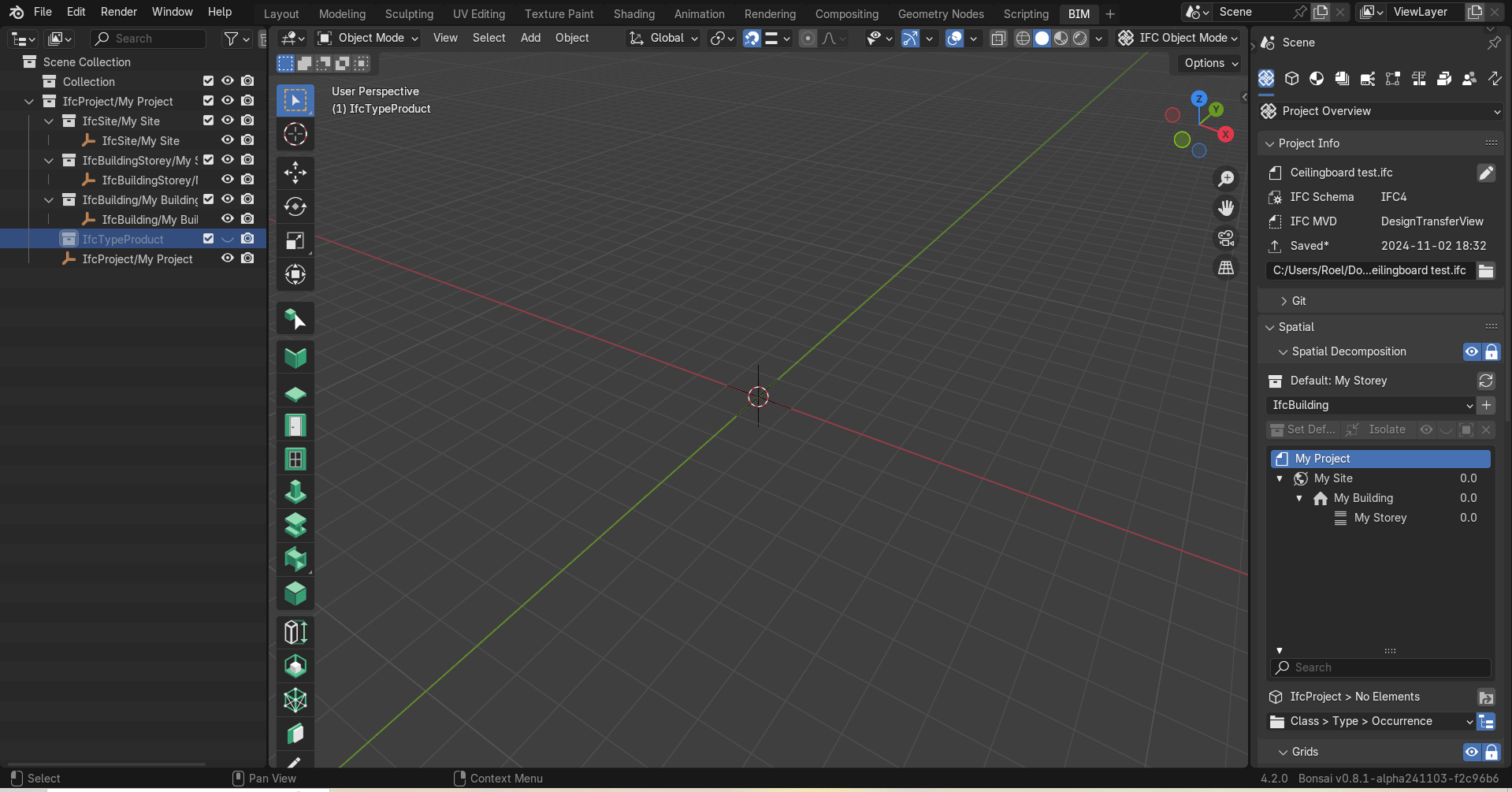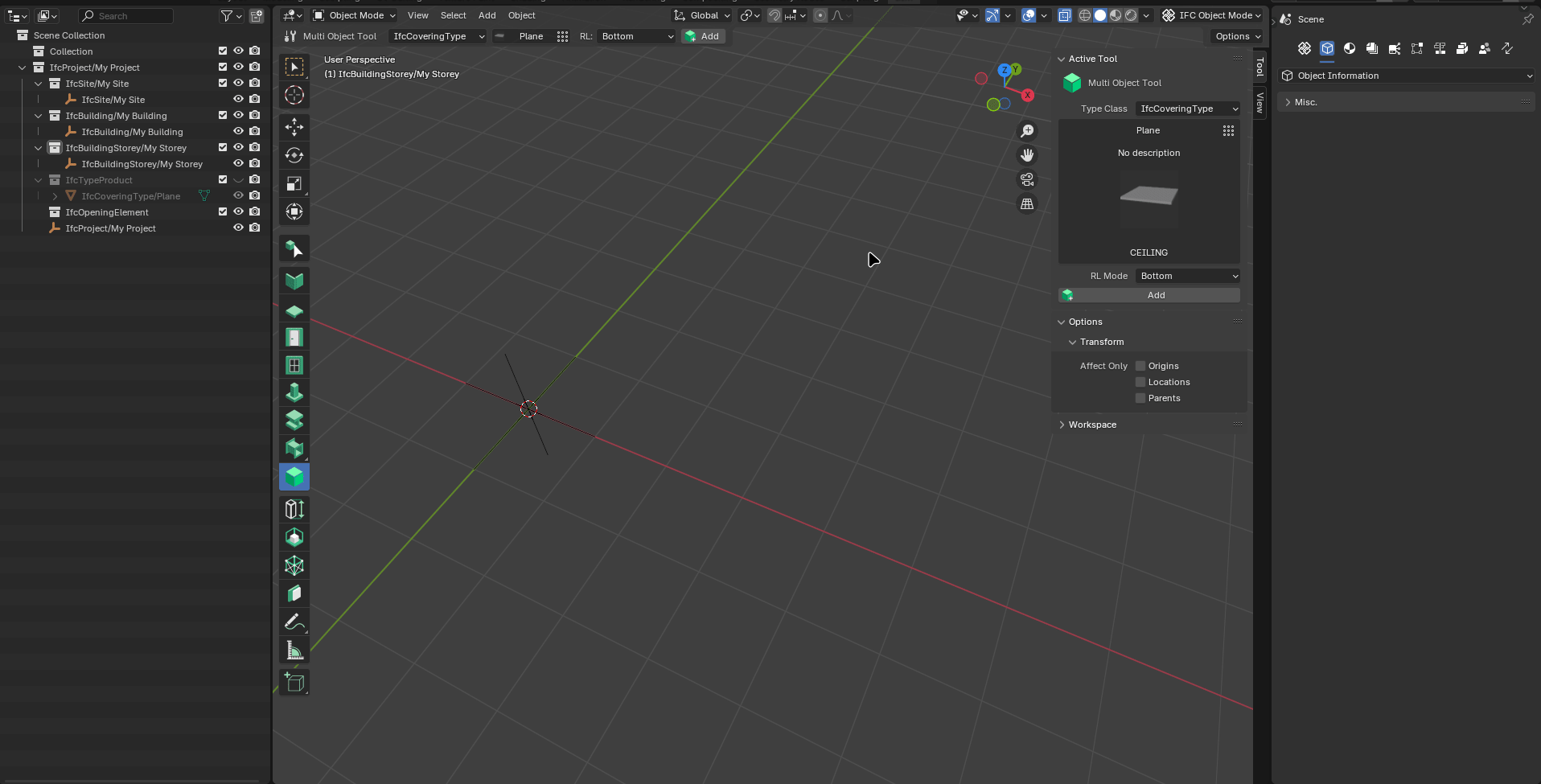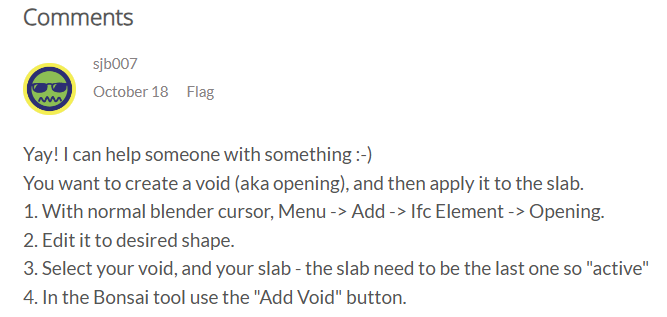R
by Roel on 4 Nov 2024, edited 27 Nov 2024
#
Could somebody please help, I have created a Type for IfcCovering[Ceiling] with a Representation “ Tessellation from Object”, when I try to “cut” the ceiling board which overlaps using Ifc Element Half Space and apply the Boolean for one selected element all the applied IfcCovering[Ceiling] elements change as per the attached low quality video clip.
Is it possible to only change the geometry of one element without creating a new IfcType? This would be handy to know how many off-the-shelf objects the project needs. The amount of waste and off-cuts can then also be calculated/managed.
Great thanks in advance for this fantastic community.
T
by theoryshaw on 4 Nov 2024
#
I can't think of a way to do this, unfortunately.
W
by walpa on 4 Nov 2024
#
hi @Roel,
Have you tried using void?

S
by steverugi on 5 Nov 2024, edited 5 Nov 2024
#
Hi @Roel
Could somebody please help, I have created a Type for IfcCovering[Ceiling] with a Representation “ Tessellation from Object”, when I try to “cut” the ceiling board which overlaps using Ifc Element Half Space and apply the Boolean for one selected element all the applied IfcCovering[Ceiling] elements change as per the attached low quality video clip.
Is it possible to only change the geometry of one element without creating a new IfcType? This would be handy to know how many off-the-shelf objects the project needs. The amount of waste and off-cuts can then also be calculated/managed.
I use IfcCovering[CEILING] quite often, "horizontal layer" where a polyline defines its extent or "vertical layer" for bulkheads.
Types allow consistency for thickness, material, etc and shape is handled by the layer orientation or, as @walpa mentioned above, use of openings where needed.
I wonder what is your actual use case that requires what you posted
Thanks
S
by steverugi on 5 Nov 2024, edited 5 Nov 2024
#
@Roel
Could somebody please help, I have created a Type for IfcCovering[Ceiling] with a Representation “ Tessellation from Object”, when I try to “cut” the ceiling board which overlaps using Ifc Element Half Space and apply the Boolean for one selected element all the applied IfcCovering[Ceiling] elements change as per the attached low quality video clip.!
Is it possible to only change the geometry of one element without creating a new IfcType? This would be handy to know how many off-the-shelf objects the project needs. The amount of waste and off-cuts can then also be calculated/managed.
Great thanks in advance for this fantastic community.
you don't always have to create a type to be IFC compliant, for custom instances you can use IfcElement, like:

G
by Gorgious on 5 Nov 2024
#
+3 votes
BTW a half space proxy plane is infinite, you don't have to extend it to encompass the mesh.
T
by theoryshaw on 5 Nov 2024
#
+3 votes
Maybe put every 'type' inside an aggregate, and only apply the void to the aggregate.
B
by BimETS on 6 Nov 2024
#
In this discussion we deal with tea, in case it can help you:
https://community.osarch.org/discussion/2579/problem-with-editing-ifc-geometry#latest
R
by Roel on 6 Nov 2024
#
@steverugi said:
I use IfcCovering[CEILING] quite often, "horizontal layer" where a polyline defines its extent or "vertical layer" for bulkheads.
Types allow consistency for thickness, material, etc and shape is handled by the layer orientation or, as @walpa mentioned above, use of openings where needed.
Thans for the feedback, I never thought to use a void, but it looks like the solution.
I wonder what is your actual use case that requires what you posted
I could be totally wrong, but I want to see how many "Off-the-shelf" (ceiling boards/floor tiles/Carpets/Wall panels /pipes…off site manufactured goods) objects would be required for the most economical design and note the off cuts. Each "cut" would also be an activity.
@BimETS said:
In this discussion we deal with tea, in case it can help you:
https://community.osarch.org/discussion/2579/problem-with-editing-ifc-geometry#latest
Thanks I have been following this post but it is slightly above my level of understanding.
@theoryshaw said:
Maybe put every 'type' inside an aggregate, and only apply the void to the aggregate.
Thanks for the suport
S
by steverugi on 6 Nov 2024
#
+1 votes
@Roel
I wonder what is your actual use case that requires what you posted
I could be totally wrong, but I want to see how many "Off-the-shelf" (ceiling boards/floor tiles/Carpets/Wall panels /pipes…off site manufactured goods) objects would be required for the most economical design and note the off cuts. Each "cut" would also be an activity.
Nice exchange, thanks
OK, I never needed to calculate the number of tiles, usually m2 is enough with some % as waste
For actual number of boards (ceiling or similar) you can duplicate and install 4x8 ones with an IfcCoveringType and edit the pieces as horizontal or vertical plane with relevant dimensions,
The way I see it you don't need to identify/measure the void since you can easily calculate that info from its original area (or use Net or Gross to appreciate the difference if holes inside the panel), much less to create bespoke types from a mesh, unless I am missing an important piece here.
Same applies to pipes, you have their individual length using qto engine and evaluate the 'cut' part according to their original standard one.
Does it make sense? cheers
S
by steverugi on 6 Nov 2024
#
+1 votes
@BimETS said:
In this discussion we deal with tea, in case it can help you:
https://community.osarch.org/discussion/2579/problem-with-editing-ifc-geometry#latest
Thanks I have been following this post but it is slightly above my level of understanding.
I think this is what you need, as listed by @sib007, if you try it is not that difficult to implement, after a few times ;)

R
by Roel on 6 Nov 2024
#
+1 votes
@steverugi said:

Ah, thanks "IfcVoidingFeature" will try it out now.
The heading of this post might be wrong now, but it looks as if it solved my problem.
S
by steverugi on 25 Nov 2024
#
hi @Gorgious
BTW a half space proxy plane is infinite, you don't have to extend it to encompass the mesh.
Half space is a super feature, incredibly useful
any chance to edit/move/rotate it once created and applied to the object?
at the moment I only know how to delete it and create a new one
thanks
S
by sjb007 on 25 Nov 2024
#
+1 votes
@steverugi said:
hi @Gorgious
BTW a half space proxy plane is infinite, you don't have to extend it to encompass the mesh.
Half space is a super feature, incredibly useful
any chance to edit/move/rotate it once created and applied to the object?
at the moment I only know how to delete it and create a new one
thanks
Yay, I can help someone else ;-)
You can show the booleans, move the boolean you want to change, select that boolean and the item to be cut, and add it again. It may or may not have an immediate effect because the original cut is still there. So you show booleans again, select the old unwanted cut, and remove it. Now the effect will definitely show. It is slightly better than adding a brand new half-space and positioning it from scratch, but it would be nice to make it so the boolean can be edited directly.
S
by steverugi on 25 Nov 2024, edited 25 Nov 2024
#
thanks @sjb007 , useful hint
to summarize:
-
create an element
-
create a half space, which is: set the 3D cursor into position, go to top menu Add > IFC Elements > Half Space, rotate/shift if needed
-
go to "booleans" under "Geometry and Materials > Geometric Relationship" and click on the + icon to apply it
say now I want to change the cut position or orientation:
-
select the cut element, click on the eye icon in "booleans" to show it, edit to my liking
-
select the half space then the element and click on the + again in "booleans" to add the new one
-
now the element shows the way I wanted (but it has two half spaces)
-
to delete the old half space click again on the eye , select the element and the old half space
-
go to "booleans" now showing a button "Remove Boolean", click to delete it
-
click on the closed eye in "Booleans" that confirms there is only 1 left
quite a procedure eh? :))
S
by sjb007 on 25 Nov 2024
#
+1 votes
@steverugi For sure that should be made smoother. I meant to raise an issue, but never got to it. I really should go and do that.
S
by sjb007 on 25 Nov 2024
#
+2 votes
Raised: https://github.com/IfcOpenShell/IfcOpenShell/issues/5800
B
by BimETS on 27 Nov 2024
#
Awesome upgrade, works well...plus some conversions, now I'm fully up to speed with Blender 4.3.



